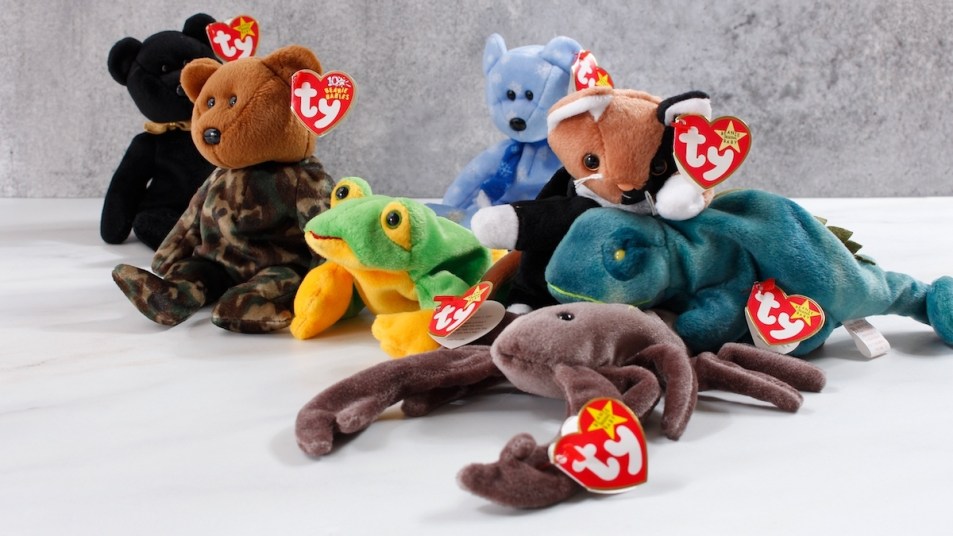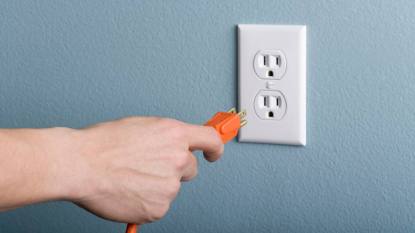Is Your 1990’s Beanie Babies Collection Worth Any Money? Experts Weigh In
The answer depends on a few factors.

Remember Beanie Babies? These pellet-stuffed creatures were all the rage in the ’90s. Easily recognizable by their small size, squishy texture, and heart-shaped “ty” tag (named for their founder, H. Ty Warner), the cute animal toys ranged from bears to whales to platypuses and for many, still elicit instant nostalgia.
An HBO Max documentary about the phenomenon, Beanie Mania, billed Beanies as “the nation’s most absurd investment fad.” The fad was spurred by a then-ascendant internet, where the value of these toys became a hot-button topic in online forums; they were eBay staples, and Vox reports that in May 1997, the site auctioned off a whopping $500 million worth of Beanie Babies, accounting for 6 percent of its total annual sales. The combination of a media frenzy (the Beanie market was the subject of many ’90s news reports, including the story of one collector whose BB stock was valued at $300,000) and a shrewd play on supply and demand by the manufacturer (many Beanies were purported to be “limited edition” and “rare”) led many people to believe that the toys would fund their retirements and put their kids through college.
There’s even a book about the phenomenon, The Great Beanie Baby Bubble, in which author Zac Bissonnette analyzes Warner’s (often shady) business tactics and argues that Beaniemania was a form of mass delusion, not unlike the “Tulip Mania” when 17th century Dutch people thought exotic flowers would yield a massive profit. Many Americans squirreled away their Beanie Babies in attics and basements after hearing talk of big-money deals and eBay success stories; the idea that a $5 toy could have a huge financial return was endlessly tantalizing.
If you still have a box of Beanie Babies sitting in your garage, you might be wondering if attempting to sell them is worth the effort. Twenty-five years later, are your BBs actually valuable? Keep reading to learn the answer.
Why did people think Beanie Babies would be worth money someday?
A stuffed animal typically calls to mind a cherished childhood companion, not a cash cow — but Beanie Babies were different. Warner, wanting to build up hype around his signature toys, made two significant decisions to signal the collectability of the product. According to Slate, he had “a remarkable talent for manipulating supply and demand,” and supplied the toys to small businesses, rather than big box retailers, in limited quantities; Warner also strategically “retired” the animals after a short time, so that they’d be seen as coveted limited edition products. These savvy marketing moves worked, and led to a retail frenzy in which adults became even more obsessed with collecting Beanie Babies than their kids (check out this 1999 picture of a divorced couple splitting up their Beanie Baby collection in court). Many parents warned their children against cutting off the heart-shaped tags or encouraged them to keep their toys in specially-designed display cases to better preserve their value.
What makes a Beanie Baby worth something?
If you or your kids still have Beanie Babies, you might be wondering how much they’re worth today. We’ve got some disappointing news: The vast majority of them aren’t worth much more than they originally sold for. Treasure Keeper, a site dedicated to collectibles, reports that most Beanie Babies are worth less than $20 today. So, while you’re unlikely to become rich off your Beanie Babies, certain BBs do sell for a decent amount, in rare cases. Here are the qualities that might make your Beanie Baby valuable:
- The Tag. If your Beanie Baby doesn’t have its original “ty” heart-shaped tag, it’s not going to be considered valuable. If your Beanie Baby does have the tag, this isn’t a guarantee of value, but it’s a good place to start. This in-depth guide shows how the tag went through many variations over the years.
- The Condition. Like most collectibles, you’ll want your Beanie Baby to be in pristine condition if you’re planning to sell it. Since these are children’s toys that were frequently played with, having a ’90s Beanie Baby in perfect condition can be a rare occurrence.
- Errors. Similar to coins, an error on a Beanie Baby can in some cases add value. Collectors are quick to note that errors don’t always equal value, since many Beanie Babies sport small typos on their tags due to the nature of mass-production. However, Beanie Babies with sewing errors, like a missing embroidered emblem, an upside-down embroidered emblem, or an emblem embroidered in the wrong place, have sold for up to $499.
What are some valuable Beanie Babies?
When it comes to Beanie Babies, older is often better. The collectors’ site Love My Beanies claims that if you have one in excellent condition that also sports a first generation heart tag (meaning it was among the original Beanie Babies introduced in 1994), it could be worth over $100.
Love My Beanies lists first generation Beanie Babies that have sold for attention-getting sums. These include a Digger (crab) that sold for $650, a Chilly (polar bear) that sold for $700, a Peking (panda) that sold for $750, and a Patti (platypus) that sold for $900. Even more impressively, a first generation Slither (snake) sold for $1,300 in 2021, and a first generation Pinchers (crab) complete with a prominent error on its tag that misstated its name as “Punchers,” sold for $1,800 in 2013.
One of the most famous Beanie Babies is the purple Princess Diana bear released as a tribute to the beloved royal following her untimely death in 1997. Because of the historical significance of this Beanie Baby, many people believed it would be one of the most valuable — but that isn’t the case. You may see Princess Diana bears listed for hundreds of thousands of dollars on eBay, but it’s important to remember that a listing price is not the same as a sold price. People can list Beanie Babies for any price they want, but collectors are unlikely to pay such an exorbitant amount. The Diana bear was wildly popular, so it was actually produced in higher quantities than many other Beanie Babies, ultimately making it less rare and therefore less valuable.
How do I sell my Beanie Babies?
If you’re planning to put your Beanie Babies on the market, make sure they’re in good condition and still have their tags, and check to see which generation they are. You’ll also want to look for any quirks, like misplaced embroideries or typos on the tags. Beware of scammer tactics (don’t put a crazy-high price on your toy just because you’ve seen others on eBay do it), and remember that many Beanie Babies, no matter how cute, are worthless — at least, as far as money goes.
This guide to searching for Beanie Babies on eBay and seeing how much they have realistically sold for can help you determine where to start. Love My Beanies, Beaniepedia, and Beanie Babies Price Guide are also useful resources for Beanie Baby collectors and sellers.
The Bottom Line
Familiarize yourself with the details of your specific Beanie Babies, do your research, and be realistic about what your stuffed animals might sell for — and you may end up pleasantly surprised, if you’re looking to make some extra cash. Certain Beanie Babies do have some value — and not just in nostalgic cuddles. We wish you the best of luck with your Beanies!
Read on for more about valuable toys:
Vintage Dollhouses Can Sell For $5000 — Find Out What *Yours* Could Be Worth!
Barbie’s Fabulous 64-Year History + Discover What *Your* Vintage Barbie Is Worth
Remember Cabbage Patch Kids? If You Still Have One, It Could Be Worth Up To $3000













